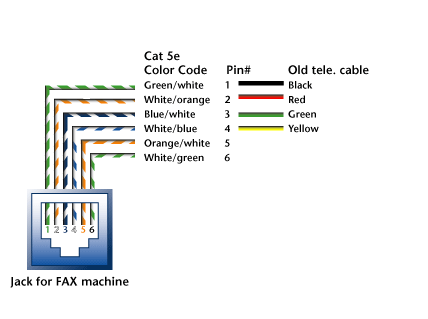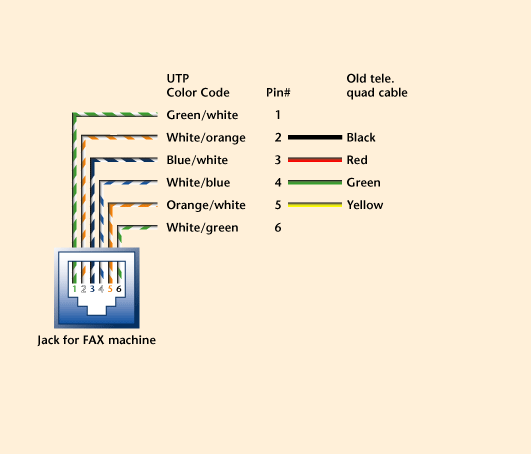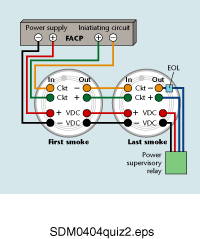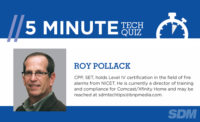Questions
1. Category 3 cable is rated to support what maximum data transmission speed?a. 1 MHz
b. 16 MHz
c. 20 MHz
d. 100 MHz
e. 200 MHz
2. Category 5 cable is rated to support what maximum data transmission speed?
a. 1 MHz
b. 16 MHz
c. 20 MHz
d. 100 MHz
e. 200 MHz
3. Category 6 cable is rated to support what maximum data transmission speed?
a. 1 MHz
b. 16 MHz
c. 20 MHz
d. 100 MHz
e. 200 MHz
4. The type 66 punch down block
is recommended for termi- nation of category 6 cables.
a. True
b. False
5. A wiremap tester will check a cable for
a. opens/shorts.
b. crossed pairs.
c. reversed pairs.
d. split pairs.
e. All of the above
6. A time domain reflectome- ter is often used to test cable length.
a. True
b. False
7. A data cable problem that couples so much of the signal being transmitted back on the receive pair that incoming signals can be unintelligible is called
a. attenuation.
b. impulse noise.
c. near-end crosstalk.
d. None of the above
8. A frequency of 1 billion cycles per second is represented as
a. 1 KHz.
b. 1 MHz.
c. 1 GHz.
d. 1 BHz.
9. What is the AWG size of the center conductor in an RG-6U cable?
a. 6
b. 12
c. 18
d. 24
10. All RG-6U cables are identical in construction.
a. True
b. False
11. All cables installed above a drop ceiling must be plenum-rated.
a. True
b. False
12. When running data cables you should avoid
a. electrical power lines.
b. fluorescent lights.
c. electrical equipment.
d. All of the above
13. Which of the following AWG wires has the highest current-carrying capacity?
a. 6
b. 12
c. 18
d. 24
14. When installing category 6 cables you should avoid
a. sharp bends.
b. pulling too hard on the cable.
c. pinching the cable with staples or ty-raps.
d. All of the above
Point A to Point B
Not all cables are created equally. Many applications require special cables that are designed to meet the requirements of current flow, frequency, or data rates. For this reason it is important that you match the correct cable to the job, because failure to do so can result in improper operation, damaged equipment, or wasted resources.
To check your understanding of when to use various types of cables, take the following quiz.

What’s Wrong with This?
Wally ‘Larman installed cabling for telephony and data communications for a small commercial client along with a burglary/fire alarm system. He used category 5e cables that were specified by his client for the telephony/data runs and properly installed them throughout the space. He carefully installed the termination equipment and tested each cable. He then connected the existing POTS line for the FAX machine as shown in this diagram, but as often happens with Wally’s work, when he was finished the FAX machine did not work. Can you see what Wally did wrong and how to correct his mistake?Answers
1. b2. d
3. e
4. b – In the past, the type 66 punch-down block was commonly used for telephony connections, but when using category 6, or similar data cables, if a punch down block is necessary, the 110 punch down block is recommended.
5. e
6. a – The time domain reflectometer also will locate impedance mismatches.
7. c – Near-end crosstalk (NEXT) is induced crosstalk measured at the end near the transmitter. Far-end crosstalk (FEXT) is crosstalk measured at the far end of the cable.
8. c – 1 KHz is 1 thousand cycles per second; 1 MHz is 1 million cycles per second. The expression 1 BHz does not exist.
9. c
10. b – RG-6U cables can differ in many ways, such as percentage of overall shielding and composition of shield (aluminum or copper) or composition of center conductor (solid copper or copper-covered steel). In addition there are RG-6U cables that are called quad shield, which have two sets of foil/braided shields.
11. b – Although you should check local codes, typically plenum-rated wire is only needed if the air space above the drop ceiling is used as an air plenum.
12. d
13. a
d – All of these actions can distort the cable, adversely affecting its parameters. In addition, when making connections you should only use connectors with the appropriate rating and not untwist the wires any more than absolutely necessary.

Answer to: What’s Wrong with This?
Wally’s problem is caused by the way he connected the old POTS wires to the category 5e cable. The old standard POTS telephone color code places the Ring (-) and Tip (+) on the Red and Green wires, which should be connected to pair #1, the blue/white pair of the category 5e cable on pins 3 and 4. The way Wally connected the wires the POTS line for the FAX machine was split between the white/orange wire and the blue/white wires. Wally should re-wire the cables as shown in this diagram and then test the FAX machine. It is important whenever working on older equipment that you understand the wiring conventions that were used and that you should check all terminations and cables before connecting any equipment.
Correction:
EOL Should Be in Series, Not Parallel SDM inadvertently published a diagram containing an error (SDM, April 2004 “5-Minute Tech Quiz Answers,†p. 87.) Due to an error in composing the art work for the diagram, the connections for the power supervisory relay were inadvertently shown as connected in parallel with the EOL resistor when they should have been shown in series. By connecting the relay in series, an interruption in power will cause an open in the initiating circuit, which will be recognized as a trouble condition by the control. The corrected diagram is shown here. SDM regrets any inconvenience that this might have caused, and thank our subscribers for bringing this to our attention.
